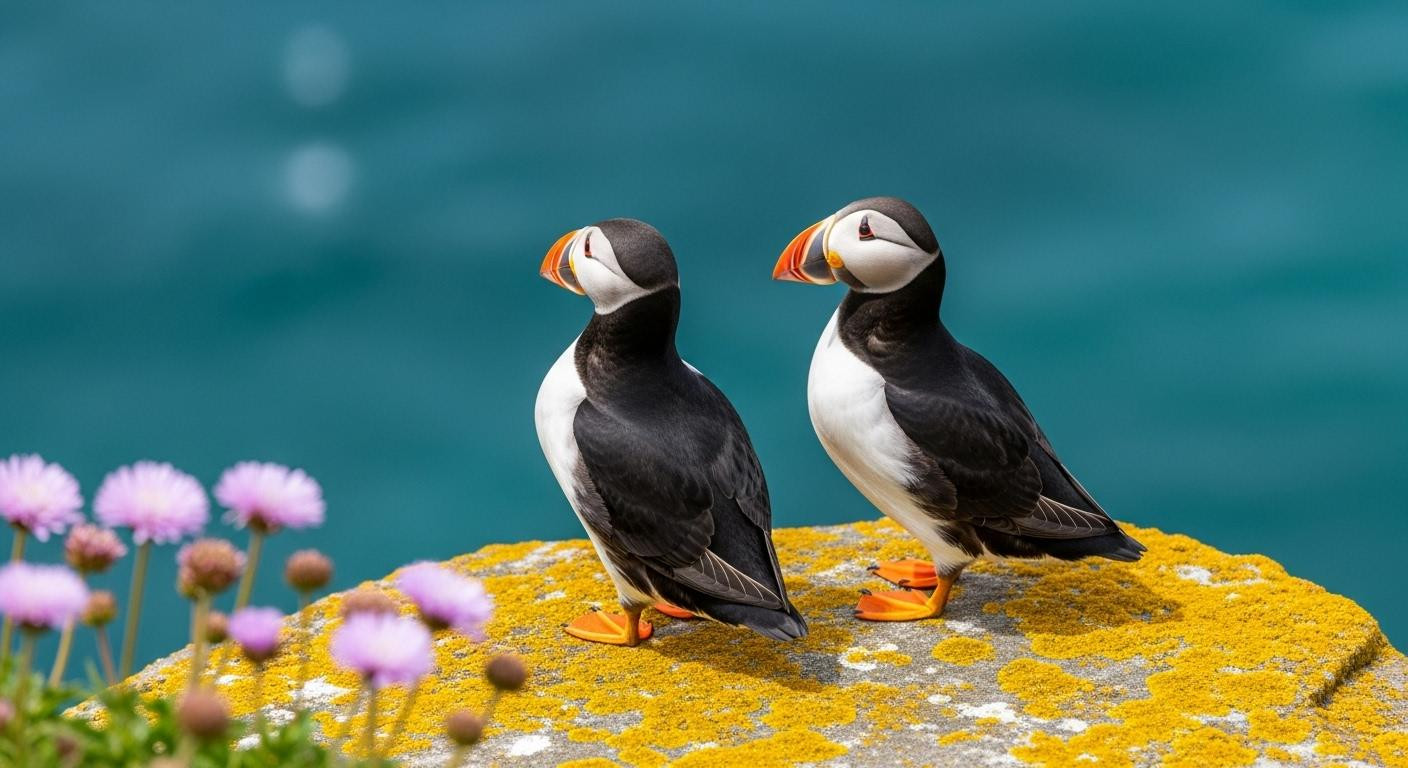At dawn, when Kilmore Quay harbor lies still under Irish mist, three boats slip quietly from their moorings. No tourist queues form at the yellow gate marked “Saltee Ferry.” No crowds jostle for the best viewing spots. Just a handful of passengers clutch thermos flasks and cameras, bound for Ireland’s most overlooked seabird sanctuary.
Great Saltee Island rises from the Atlantic 3 miles offshore. Weather permitting, 20 minutes by charter boat. What awaits feels impossibly intimate: over 1,000 puffin pairs nesting within arm’s reach, purple wildflower meadows unmarked by tourist trails, limestone cliffs where silence reigns.
While Wales’ famous Skomer Island processes thousands of daily visitors on scheduled ferries, Great Saltee receives fewer than 2,000 people annually. The contrast reveals everything about Ireland’s best-kept wildlife secret.
The 20-minute crossing locals never post on social media
Charter boats depart Kilmore Quay between April and August only. Weather cancellations are common. No schedules guarantee departure times. This unpredictability keeps visitor numbers manageable.
Three operators share the 120-acre island: Saltee Ferry, Three Sisters Cruise Company, and Saltee Sea Safaris. Each charges approximately $44 for adults, $22 for children under 12. Daily capacity maxes out at 72 visitors across all boats.
The journey crosses open Atlantic waters. GPS coordinates 52°7′N, 6°36′W mark Ireland’s southeastern frontier. No dock awaits arrival. Visitors transfer to smaller boats, then wade ashore through shallow water. Feet get wet. This 820-soul Irish island nearby offers similar authentic experiences locals protect.
According to boat operators, bookings rely entirely on word-of-mouth recommendations. No aggressive marketing campaigns promote the island. The yellow gate at Kilmore Quay’s harbor remains unmarked except for essential signage.
Where 1,000 puffin pairs nest closer than Instagram allows
Great Saltee’s magic unfolds within minutes of landing. Puffins waddle between visitors’ legs like “tipsy toddlers,” according to recent travel accounts. No barriers separate wildlife from humans. No designated viewing areas restrict movement.
Purple wildflowers and yellow-moss boulders
Spring transforms the island into a natural carpet. Sea pinks and purple clover blanket limestone plateaus. Yellow moss coats weathered boulders where puffins rest between fishing trips. The visual contrast rivals Iceland’s Westman Islands, but with zero commercial development.
Clifftops rise 200 feet above turquoise water. Gannets, guillemots, and razorbills nest in sea caves and rock crevices. Photography opportunities remain unscripted, unhurried.
The Neale family’s 1943 sanctuary decision
Private ownership since 1943 explains Great Saltee’s uncommercialized character. The Neale family maintains the island as a bird sanctuary. No UNESCO designation exists, yet Important Bird Area status protects nesting colonies.
Unlike Skomer’s 10,000+ puffin pairs accessed via structured viewing platforms, Great Saltee offers intimate encounters. Visitors explore freely across 1.2 square miles of wild terrain. Overlooked islands where locals outnumber tourists share this authentic atmosphere.
What $44 buys that Skomer Island’s $88 ferry cannot
Great Saltee delivers privileges money rarely purchases elsewhere. Solitude tops the list. On peak summer weekends, maybe 24 visitors share the entire island. Skomer processes 800 daily during high season.
Sunrise clifftop silence and storm-watching
Early departures capture golden hour light without crowds blocking camera frames. Puffins emerge from burrows as dawn breaks over the Atlantic. The eastern cliffs offer panoramic views toward Wales, 84 miles northeast.
Stormy days create dramatic seascapes. Atlantic swells crash against limestone stacks while seabirds navigate fierce winds. No safety announcements interrupt the natural theater. Visitors experience Ireland’s wild coast unfiltered.
Picnic provisions and leave-no-trace ethics
No cafés, restaurants, or facilities exist on Great Saltee. Visitors pack lunches from Kilmore Quay’s seafood shops. Local specialties include Saltee Smokies (smoked fish) and fresh crab, typically costing $17-28 per meal.
Boat operators emphasize environmental respect. Leave-no-trace principles protect nesting birds. The island’s pristine condition depends on visitor restraint. This Greek island with lower costs than Santorini demonstrates similar sustainable tourism approaches.
The Atlantic light Skomer Island never captures
Ireland’s softer climate creates unique photographic conditions. Morning mist wraps Great Saltee in ethereal veils. Afternoon light turns limestone cliffs pink and gold. Weather changes bring constant visual surprises.
Unlike managed sites with PA announcements and scheduled activities, natural acoustics dominate. Only seabird calls, wind through grass, and waves against rocks create the soundtrack. This silence feels increasingly precious in 2025.
Departure at 4pm leaves the island to its wildlife residents. Puffins return to clifftop burrows as tourist boats fade toward Kilmore Quay. The privilege of temporary coexistence with wild Ireland lingers long after landing. Year-round island escapes offer complementary seasonal experiences.
Your questions about few tourists visit this island where puffins outnumber people answered
When can I visit and how much does it really cost?
Puffin season runs April through July only. Charter boats cost $44 per adult, $22 for children. Weather cancellations occur frequently during shoulder months. Kilmore Quay accommodations range $88-198 per night. Total trip costs significantly less than comparable Welsh puffin experiences.
Why don’t more tourists know about this island?
Private ownership limits promotional activities. No scheduled ferry infrastructure exists like Skomer’s commercial operation. Local boat operators deliberately avoid aggressive marketing campaigns. Weather-dependent access naturally restricts visitor numbers. Recent travel surveys show fewer than 2,000 annual visitors despite proximity to Dublin.
How does it compare to Scotland’s puffin islands?
Great Saltee sits just 84 miles from Dublin versus 250+ miles to Scottish colonies. Access costs half the price of Isle of May expeditions. Atlantic character differs from North Sea environments. Intimate scale allows closer wildlife encounters than larger Scottish sites.
The evening boat pulls away from Great Saltee as puffins settle into clifftop burrows. Behind, wildflower meadows glow pink in sunset light. Ahead, Kilmore Quay’s harbor keeps its secrets well. Some sanctuaries stay sacred through discretion, not designation.
